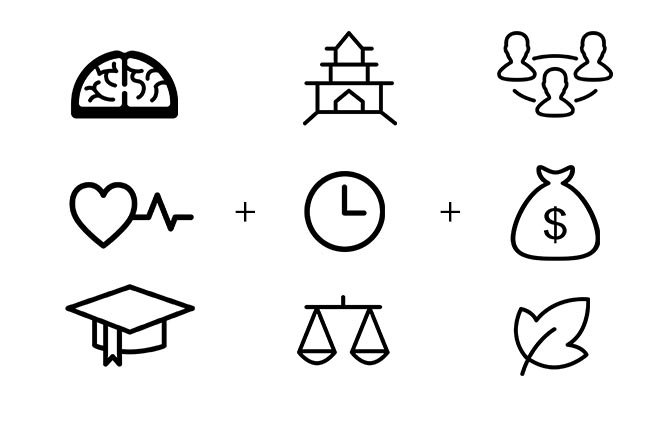"What would you consider a good quality of life to be?"
"Balance," Bethany, USA
"Human rights & happiness," Liisa, Sweden
"The freedom to comprehensively pursue a want or goal to the best of one's ability," Kojo, Ghana
“National Income, 1929-1932.” That was the name of the report authored over 80 years ago by Simon Kuznets, an American economist.
Bear with me: I promise it's relevant!
The report calculated the net production of the US economy as an attempt to track the recovery from the Great Depression. Little did Kuznets know, his report would form the basis of the tool used by the world to measure economic progress: Gross Domestic Product (or GDP).
The report came with a disclaimer at the end: the assumption that a high GDP means a better-off nation, and therefore a better quality of life for the average citizen, isn't necessarily true.
But isn't that exactly what governments have assumed? Hasn't GDP become the main indicator of success?
The problem with using GDP to measure quality of life is all that it leaves out. Take distribution. The richest 10% of the population in China makes 25 times more than the poorest 10%, even though China has the second largest GDP. GDP doesn't measure personal freedoms or access to basic resources either. An LGBT person's life in Saudi Arabia (20th in GDP) wouldn't be any better than it would be in Mauritania (148th).
The thing is, how can progress be measured when progress means different things for different people? Thankfully, organizations and people have created indices to help us measure standards of living that are more relevant to the way our world has evolved since the 30s.
1. Gross National Income per Capita (PPP)

GNI per capita, a cousin of GDP, is slightly more relevant to quality of life. What exactly is the advantage of a per capita calculation? It divides a nation’s money by number of people. Singapore has the second highest GNI per capita, but it's a tiny country. If we just looked at GDP we'd think Singapore, with it's 5 million citizens, was completely out of the running for best QOL (5 million is a drop of water in the ocean of China's 1.3 billion people).
This measurement also represents QOL more realistically by accounting for Purchasing Power Parity (PPP). A country’s currency is inflation-adjusted, roughly showing the value it has for people. For example, you can buy a lot more (purchasing power) with $1 in Vietnam than you can in Germany.
2. Human Development Index

According to the United Nations Development Programme, you would need “a long and healthy life, knowledge and a decent standard of living” to be in good socioeconomic standing. That's why they created the Human Development Index. A long and healthy life is defined by the HDI as life expectancy. Mean and expected years of schooling make up the knowledge criterion, and GNI per capita PPP (hey, that looks familiar!) is used to quantify the decent standard of living component.
Now we’re getting somewhere! Right? Well, hang on, what about human rights and environmental degradation?
Okay, back to the drawing board.
3. Social Progress Index

Holy icons, Batman!
The SPI was created in 2014 by Michael Green and it’s composed of three components: basic human needs, foundations of wellbeing, and opportunity. Sounds simple right?
Well, no. "Basic human needs" (the first column of icons) is comprised of 4 things: nutrition and basic medical care, water and sanitation, shelter, and personal safety. (There's even ecosystem sustainability and tolerance and inclusion sub-components!)
But wait, theres more: Each one of these is composed of over 3 measurable indicators. For example, "access to information and communication" (the wifi signal icon) is comprised of the number of internet users and extent of press freedom.
4. Gross National... Happiness?

GNH was developed by Bhutan's fourth king in 1972, and has been a preferred measurement in the small nation ever since. When I first found out about GNH, I expected it to be fluffy. It sounded nice, but how would you even go about measuring happiness?
There are 9 ways, evidently! Bhutan uniquely considers psychological well-being, culture, time-use, good governance, community vitality, and ecological diversity and resilience.
Similar to SPI, each component has various indicators. Some of these are quite hard to measure and involve many surveys, but it's impressive that the government goes through that trouble.
5. The Nomad Happiness Index

Okay, I made this method up.
I am constantly moving. As a traveler, a window seat and the ability to find a bathroom in a foreign country are handy. The firmness of the hostel pillow maybe isn't as important, but hey, it's my index.
On a more serious note, the emotional connections I make on the journeys I take are vital to the experience, and the ability for me to speak the local language helps this aspect. From my experiences, by making cross-cultural connections, I become one ecstatic nomad.
From Ghana to the UNDP to Bhutan, everyone has a slightly different idea of what quality of life is. It is apparent, however, that all of these indices were created to benefit even the most vulnerable communities and individuals. We keep seeing 3 things over and over again: Health, education, and income. It shows that to improve quality of life, alleviating extreme poverty is the first step.
So... What would you consider a good quality of life?